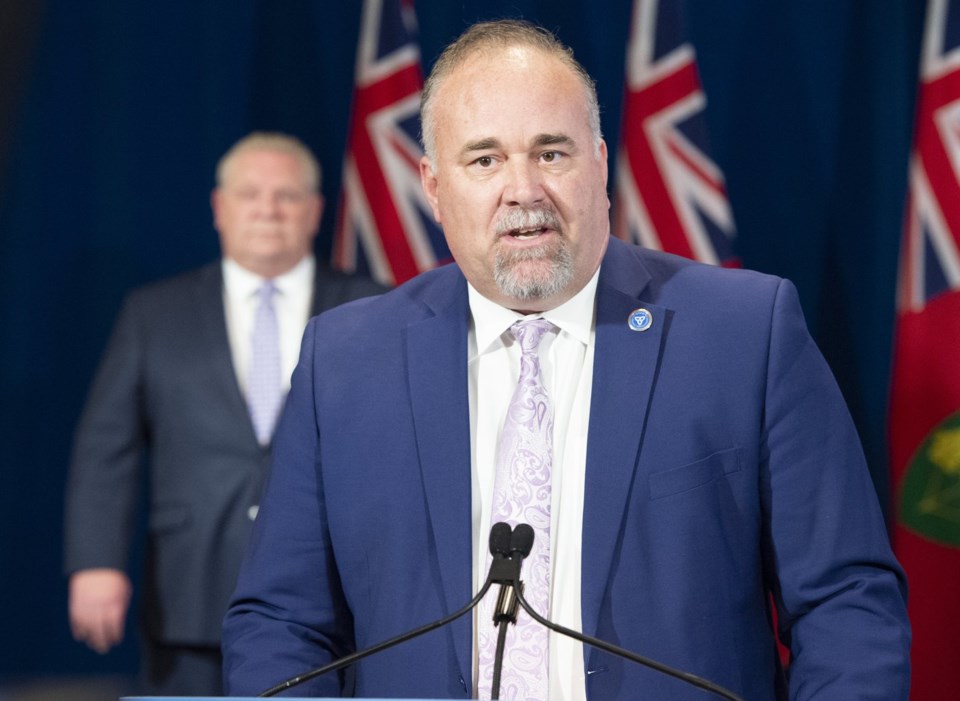TORONTO — Ontario child-care operators in the national $10-a-day program will soon be compensated in a way the province says will cover the true cost of providing care, after many said they were struggling to keep their doors open under the current structure.
Education Minister Todd Smith is set to announce a long-delayed new funding formula Thursday, saying he thinks it will prevent closures and give operators certainty and stability.
"Given the feedback and the extensive consultation that's taken place on the new funding formula, we're pretty comfortable that those who are operating and those who want to operate are going to be able to do so in the province, creating those much needed spaces that families are looking for," he said in an interview.
The new funding structure, which will come into effect Jan. 1, also comes with an announcement that as of the same day the fees parents pay will be further reduced. They have already come down about 50 per cent to an average of $23 a day and next year will fall to an average of $19, and capped at $22.
Those will be cut further to an average of $10 a day by March 2026, a date pushed back from an earlier pledge of September 2025.
The updates to how operators are compensated for lower parent fees, however, do not come with any new wage increases or a wage grid for early childhood educators, something advocates and many operators have said is key to not only expansion of the sector but also maintaining existing spaces.
But Smith said under the new funding formula, operators will have more flexibility with their spending, leaving some more able to boost staff pay.
Carolyn Ferns, policy co-ordinator for the Ontario Coalition for Better Child Care, said the new model helps set current centres up for success, but is lacking when it comes to expanding child care.
"I think that it does make things more stable from where they were, but they were in a very bad place, so that's a bit of a low bar," she said.
"But really to set things up for how we go forward...this isn't solving the workforce crisis, and it's not providing enough accountability for how public funding is being used."
Currently, the government is covering the amount of money parents are saving through reduced fees, but centres say just replacing revenue based on fees that were frozen in 2022 isn't covering the true cost of providing care.
Officials say the new funding formula will ensure no operators in the $10-a-day program will experience a loss.
Starting next year, operators will get a main pool of funding based on several factors such as how many spaces they operate, how many children they serve in each age group, and the region in which they're located.
Officials say about half of operators will have their costs fully covered by that amount, then there will also be a "legacy top up," so existing operators in the program can pay expenses that exceed typical ones, such as higher catering costs to offer kosher food or higher rent based on their location.
The formula will set an average eight-per-cent profit for for-profit operators and an average eight-per-cent surplus for non-profit operators.
Amy O'Neil, the director of the non-profit Treetop Children's Centre in Toronto, said she is concerned that the two types of operators are being treated the same in that respect, since commercial centres may put that money toward profits, but non-profit operators reinvest surpluses into their centres.
In general, she said, it seems like the government listened to operators' concerns and she is particularly pleased that centres in more expensive regions will get more funding to cover associated costs because it has been difficult under the current formula.
"(We're) just basically trying to keep our head above water for the last two years," O'Neil said. "We’re running on a deficit, our organization, and we’re using our reserves and our reserves are dwindling."
The government also hopes the new structure will help new and existing operators to create more spaces, adding a growth top-up to the formula.
Ontario's deal with the federal government committed the province to 86,000 new child-care spaces. But, so far, while there have been about 51,000 new spaces for the kids five and under, the age group covered by the national program, only 25,500 of those are within the $10-a-day system, officials say.
The growth top-up will give operators an amount of money for space creation based on their geographic region.
Smith and the Association of Municipalities of Ontario recently sent a joint letter to federal minister Jenna Sudds, saying a cap on for-profit spaces in Ontario's deal is hampering child-care expansion in the province, and they are asking her to lift it.
Sudds said in her reply that delays in the province releasing its new funding formula have created uncertainty in the system, and she wanted to see that new structure as well as more data before making a decision.
Sudds said in a statement Thursday that she is glad to see Ontario has released its new formula and is further lowering fees for parents.
"That said, the job’s not over," she wrote.
"Ontario needs to keep its foot on the gas in order to meet the targets that it agreed to. That includes good pay and working conditions for child care workers, and creating thousands of new child care spots."
This report by The Canadian Press was first published Aug. 15, 2024.
Allison Jones, The Canadian Press
